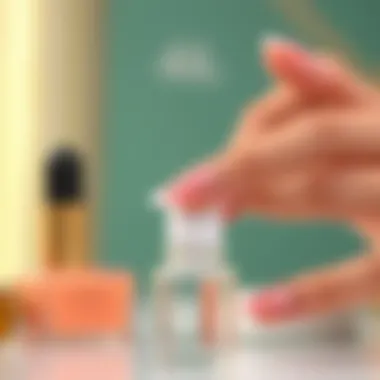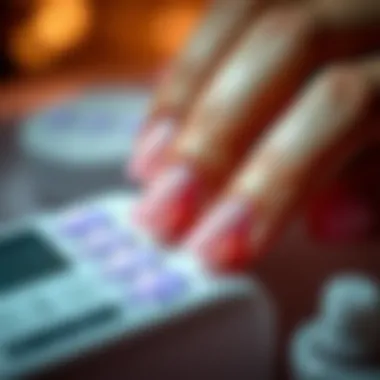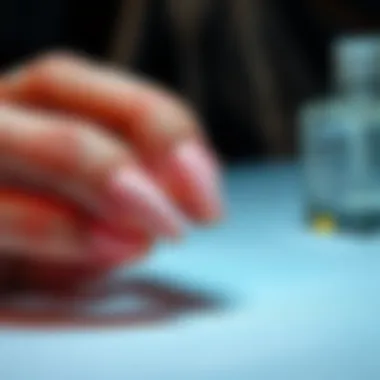Understanding Gel Nail Primer and Dehydrator Functions


Intro
In the bustling world of nail care, there are essentials that often go unnoticed yet play pivotal roles in the end result—two of them being gel nail primer and dehydrator. Both products are designed to enhance the adherence of the gel polish to the nails while also contributing to the overall health of the nail bed. This nuanced understanding of these items allows both professionals and hobbyists to elevate their nail application process.
Nail artists often find themselves at a crossroads when deciding between products, which can lead to confusion. There’s a general misconception that a primer and a dehydrator serve identical functions; however, they are more like complementary pieces of a puzzle rather than duplicates. Knowing the distinct actions of each can spell the difference between a manicure that lasts and one that chips within days.
In this guide, we will delve into the unique characteristics and applications of gel nail primers and dehydrators. From examining the chemical properties that underpin their effectiveness to the techniques that lead to a superior finish, this exploration aims to arm you with knowledge that boosts both your confidence and skill in nail application.
Let’s peel back the layers and get to the heart of why understanding these components makes all the difference in achieving perfect nails.
Prolusion to Gel Nail Application
In the world of nail care, the significance of proper application techniques cannot be understated. Gel nail applications have soared in popularity, becoming a staple for professionals and enthusiasts alike. Achieving that sleek and polished look takes more than just skill; it requires a solid foundation through appropriate preparation. This is where the gel nail primer and dehydrator come into play.
Importance of Nail Preparation
Before diving into the application, it’s crucial to mention the importance of thorough nail preparation. Think of it like laying a strong foundation before constructing a building. Without this essential step, even the best manicure might not hold up. Improperly prepared nails can lead to a host of problems, such as lifting, chipping, or even an uneven application. A well-prepped nail surface allows for maximum adhesion of gel products, ensuring they stay put longer.
Additionally, preparing the nails helps in removing natural oils and moisture, which could interfere with the bond of the gel. If you skip this crucial phase, your artistic endeavors may fall flat, quite literally. Nail preparation sets the stage for the entire process, impacting not only appearance but also longevity.
Overview of Gel Nail Products
A myriad of gel nail products exists on the market today, each with distinct roles in the nail application process. Two core components are the gel nail primer and dehydrator. They are often used in tandem, yet their functions are quite different.
- Gel Nail Primer: This product acts as a bonding agent between the nail and the gel polish, enhancing adhesion.
- Gel Nail Dehydrator: Meanwhile, the dehydrator plays a vital role by stripping oils and moisture from the nail bed, providing a clean slate for the gel application.
Understanding these products’ unique contributions is paramount for anyone looking to elevate their nail artistry. Properly using both can yield results that are not only more durable but also enhance the overall aesthetic appeal of a manicure. Through careful analysis of their chemical properties, application techniques, and effects, we can pave the way for perfect nails that last.
Understanding Gel Nail Primer
Grasping the function of gel nail primer is a cornerstone when it comes to achieving a flawless nail application. It plays a pivotal role in prepping the nail surface, allowing the gel to adhere properly and ensuring a longer-lasting finish. Not understanding this may lead to potential pitfalls, like peeling or chipping, which can ruin an otherwise polished look.
A good primer sets the stage for a successful manicure or pedicure, making it essential for professionals and enthusiasts alike to be well-informed about what it entails.
Definition and Composition of Primer
A gel nail primer is a specialized product designed to prepare the nail surface for gel coating. Typically, it's a liquid or non-greasy substance that promotes the adhesion of gel products.
Some of the key components in a gel primer can include:
- Bonding agents: These help the gel stick better to the nail.
- Resins: Provide a smooth and flexible finish.
- Solvents: These substances help the primer dry quickly and evenly.
Understanding these elements is vital because they dictate how effective the primer will be in enhancing the overall gel application.
How Primer Functions
The mechanism of a gel primer is quite fascinating. Essentially, it creates a tacky layer on the surface of the nail, which acts as a bridge between the natural nail and the gel. Here’s how it works step-by-step:
- Application: The primer is applied after the nail surface is properly prepared.
- Evaporation and Bonding: As it dries, the solvents evaporate, leaving behind a sticky layer.
- Gel Adhesion: This sticky layer is crucial; it ensures that the gel polish will adhere properly, thus increasing durability.
Without it, the gel may not bond correctly, leading to various issues like lifting or bubbling.
Types of Gel Nail Primers


Different types of gel nail primers exist, each with its own unique attributes. Understanding these types allows for better application based on specific needs.
Acid-Free Primers
Acid-free primers are crafted to be gentler on the natural nail. They are popular for several reasons:
- Key Characteristic: They contain no harsh acids, making them less irritating.
- Contribution: They work well on sensitive skin and nails, providing a safer option for clients who may experience discomfort from acid-based products.
- Unique Feature & Advantages: These primers bond effectively without the risk of damaging the natural nail, which is of paramount importance in maintaining nail health. While they may not offer the same aggressive adhesion as acid-based priming agents, they are ideal for the majority of clients.
Acid-Based Primers
In contrast, acid-based primers function with a more aggressive approach, making them highly effective in certain situations:
- Key Characteristic: They contain acids, such as methacrylic acid, which enhances adherence by etching the nail’s surface.
- Contribution: Ideal for oily nail types or gel products requiring a strong bond, acid-based primers can significantly reduce the chances of lifting.
- Unique Feature & Disadvantages: While they promote excellent adhesion, the downside is the potential for irritation or damage if not used correctly. They are generally better suited for experienced technicians or clients without sensitive skin.
Benefits of Using a Primer
Using a gel nail primer provides several notable advantages:
- Enhanced Bonding: This ensures your gel nails last longer without chipping or peeling.
- Smoother Finish: It promotes an even application and a polished look, eliminating unsightly imperfections.
- Protective Layer: Primers can serve as a barrier between the nail and tough gel applications, reducing damage.
- Time-Saving: A solid primer can speed up the gel application process, leading to more efficient sessions.
In essence, the understanding and proper use of gel nail primers can make all the difference between a striking set of nails and a disappointing experience.
Navigating Gel Nail Dehydrators
In the landscape of nail application, dehydrators might not get the spotlight like gel nail primers, but their role is equally crucial. Understanding navigating gel nail dehydrators can greatly influence the outcome of a nail treatment. Simply put, these products prepare the nail surface by ensuring it’s devoid of moisture, which can lead to better adhesion and longer-lasting results.
Definition and Composition of Dehydrators
Gel nail dehydrators are specialized liquids designed to remove moisture from the nail surface. They are often a blend of alcohol and other solvents like acetone. These ingredients work together to strip the natural oils and moisture present on the nails, creating an optimal environment for products to bond effectively. Without a proper dehydrator, you run the risk of lifting or bubbling in your gel application, leading to an overall poor finish that nobody desires.
Functionality of Dehydrators
The primary function of a dehydrator is to create a moisture-free environment on the nail plate. This is essential for ensuring that the gel polish adheres properly. By evaporating surface moisture, the dehydrator opens up the nail’s pores, which makes the gel fill these spaces and grip better. In a nutshell, when you skip this step or underestimate its significance, the results can be disappointing; bubbling or peeling can occur down the line.
Different Forms of Dehydrators
Liquid Dehydrators
Liquid dehydrators are the traditional form you often see in salons. They come in small bottles and are applied directly to the nail using a brush or a cotton pad. Liquid dehydrators are popular because they dry quickly and provide an effective moisture-removal process. Their key characteristic is fast evaporation, which minimizes the time nails are exposed to moisture. However, one downside can be the strong odor, which may not be pleasant for everyone. Even so, their efficiency in promoting adherence of products is well-regarded in the nail care community.
Spray Dehydrators
On the other hand, we have spray dehydrators, which offer convenience and ease of use. These can be sprayed onto the nail surface, providing an even coating without the fuss of brushes or pads. Their notable characteristic is the fine mist application, which can reach areas that might be hard to cover with a liquid application. However, one should take care not to overspray, as this can lead to a film forming instead of a proper, moisture-free surface. Despite that, they are often preferred by professionals for their quick application and minimal clean-up time.
Advantages of Dehydrators in Nail Care
The advantages of using dehydrators are significant:
- Improved Adhesion: They greatly enhance the bond between the natural nail and the gel polish, reducing lifting.
- Longer Wear Time: By ensuring a moisture-free base, they help to extend the life of gel polish applications.
- Reduced Risk of Imperfections: Users can avoid common issues like bubbling or peeling that arise from moisture.
Discovering the right dehydrator for your needs can elevate your nail game, whether you're a seasoned professional or just dipping your toes into the world of nail artistry.
Comparative Analysis: Gel Nail Primer vs. Dehydrator


Analyzing the distinct roles of gel nail primer and dehydrator is crucial for those invested in nail care, whether they are professionals in the industry or passionate hobbyists. Understanding their unique contributions allows for better decision-making in the nail application process. Each product plays a pivotal role in enhancing the durability and aesthetic appeal of gel nails but serves different functions.
Key Differences
At first glance, gel nail primer and dehydrator might seem interchangeable, but they are as different as chalk and cheese. Here are a few key differences:
- Chemical Composition: Gel nail primers tend to have a thicker viscosity and often include latex or acrylates, which bond with the gel color. Dehydrators, in contrast, usually contain alcohol or acetone, designed primarily for moisture removal.
- Functionality: The core function of a primer is to aid adhesion between the nail and the gel polish. On the flip side, dehydrators prep the nail surface by reducing moisture, creating an optimal canvas for the primer and subsequent gel layers.
- Application Order: Primers should always follow dehydrators in the application process. This ensures that the nail is not only dry but also ready to securely hold the gel polish.
Understanding these differences can help you utilize both products to their fullest potential.
When to Use Each Product
Timing is everything, they say, especially when it comes to nail care. Knowing when to apply gel nail primer versus dehydrator can make or break your manicure. Here's a little breakdown:
- Use Dehydrator First: Always start with a dehydrator before doing anything else. Apply it to clean nails to strip away any leftover moisture or oils. This preparation stage is essential for achieving a long-lasting bond.
- Follow with Primer: After the dehydrator has done its job, proceed with gel nail primer. This layer helps the gel polish adhere better to the nail surface, minimizing the risk of lifting or peeling over time.
In summary, utilizing both products with an understanding of their roles can significantly enhance the quality and longevity of gel nails. By carefully choosing when to implement each in the application process, nail artists can achieve stunning and durable results that are sure to impress.
Application Techniques and Best Practices
When embarking on the journey of gel nail application, understanding the right techniques is paramount. The manipulation of both gel nail primer and dehydrator requires a delicate balance, as each serves a distinct purpose in the nail care process. Proper application not only enhances the aesthetic appeal of the nails but also ensures longevity and durability, preventing future mishaps like peeling or lifting.
Leaning into the best practices for these products can dramatically improve the final results. Here are some key elements to consider:
- Surface Preparation: Begin by prepping the nail surface thoroughly. Clean and buff the nails to remove any oils or residues that might hinder the effectiveness of the primer or dehydrator.
- Correct Product Application: Apply each product in thin layers, as thicker applications can lead to uneven curing and other issues. Less is often more when it comes to achieving that salon-quality finish.
- Following Instructions: Always refer to the manufacturer’s guidelines for specific drying times and application steps. Different products may vary, so understanding their distinct requirements can mean the difference between success and frustration.
- Environmental Conditions: Consider the environment you’re working in. Humidity and temperature can significantly affect the efficacy of both primer and dehydrator. Aim for a controlled environment that's conducive to nail application.
By embracing these best practices, nail artists and enthusiasts alike can navigate the often intricate world of gel application with confidence and precision.
Step-by-Step Guide for Primer Application
The application of gel nail primer is a crucial step that lays the groundwork for a successful manicure. Follow these steps for optimum results:
- Prep Your Nails:
- Apply the Primer:
- Cure the Primer:
- Assess the Application:
- Ready for Gel Polish:
- Start with clean nails, free from oils and remnants of nail polish. A gentle buffing can ensure better adhesion.
- Using a brush, apply a thin layer of primer over the nail bed. Keep it away from the skin to minimize irritation.
- Place your nails under the UV or LED lamp. Follow the manufacturer's instructions on the specific curing time necessary for the primer to set properly.
- Once cured, make sure the surface is dry and tacky. If it feels too wet, consider additional curing time.
- Now your nails are primed and ready for the next layer of gel polish. This step is vital for achieving that desired lasting finish.
Step-by-Step Guide for Dehydrator Application
Applying a dehydrator is equally essential and sets the stage for the primer to function optimally. Here’s how to do it effectively:
- Nail Preparation:
- Apply the Dehydrator:
- Allow to Dry:
- Check the Texture:
- Transition to Primer:
- As before, ensure nails are clean and free of products. Apply nail clippers or a file to refine the edge if needed.
- Using the applicator, apply a thin film of dehydrator evenly across each nail surface. Avoid over-saturation.


- Let the dehydrator dry naturally for a moment. This usually takes just a few seconds, as you want the nails to be tack-free.
- Once dried, the nails should feel dry and slightly rough to the touch. If there's any shine left, consider a second application.
- After the dehydrator has taken effect, you can proceed to apply the gel nail primer, ensuring a robust bond for your gel polish.
Applying both primer and dehydrator accurately is much like laying the foundation before building a house; it's all about ensuring everything is solid before moving onto the next phase.
Addressing Common Issues and Solutions
In the world of nail care, missteps can occur that can affect not just a single application, but perhaps the longevity and aesthetic appeal of the nails over time. Addressing common issues that emerge from the improper use of gel nail primer and dehydrator is crucial for achieving that flawless look everyone desires. Understanding these problems also opens pathways to better practices, ultimately leading to enhanced durability and satisfaction in nail artistry.
Problems Arising from Improper Use
Peeling or Lifting
Peeling or lifting is a common issue that can occur when gel nails are not applied correctly. This often results from improper adhesion between the natural nail and the gel layers above. When the primer isn't utilized properly or the dehydrator isn't fully effective, it creates a situation where the gel lacks grip, leading to the unfortunate peeling of layers. This is particularly significant because it detracts from both the beauty and durability of the application, leaving users frustrated with the way their nails look.
One notable characteristic of the peeling phenomenon is that it usually happens near the free edge of the nail. This area can be a hotspot for issues if the nails haven't been ideally prepped; hence, it becomes not just an inconvenience, but also an aesthetic faux pas. It’s clear that ensuring proper application of both primer and dehydrator is pivotal in securing that all-important bond which holds the gel securely to the nail.
The downside of peeling leaves nail enthusiasts often feeling disheartened because it can shorten the lifespan of their manicures. Hence, investing time and care at the beginning of the application process pays dividends in the long run. The primary from this issue centers around ensuring that each nail is adequately dehydrated and primed, to stave off these common pitfalls.
Bubbles or Inconsistencies
Another problem that stylist and nail painters encounter is the formation of bubbles or inconsistencies in the gel surface. These irregularities not only spoil the smooth appearance that gel nails are known for but can also lead to a more significant issue in terms of nails lifting off entirely. Blistered surfaces can occur predominantly due to excess moisture or air being trapped under the gel, potentially caused by ineffective dehydration processes. Without the right care of the nails prior to application, this dilemma can spring up quickly.
The key takeaway with bubbles is that they aren't merely cosmetic flaws; they can hint at larger failures in the application process itself. When a nail isn't properly dehydrated, or the primer isn’t applied evenly, it sets the stage for bubbles, disrupting the beautiful finish that should be achieved. This inconsistency can be particularly frustrating for professionals looking to create high-quality work.
Being meticulous in nail preparation can lead to a massive reduction in such issues. A well-executed strategy involving the right choice of products and their correct application plays a critical role in the ultimate success of nail art.
Tips for Optimal Performance
To avoid the frustrations of peeling and inconsistencies, there are some best practices that one can follow:
- Ensure nails are properly cleaned and free of any oils before using a dehydrator.
- Apply the dehydrator evenly across the nail surface, allowing complete drying before adding the primer.
- When using primer, ensure it reaches all edges without pooling; this helps in even adhesion.
- Use a light touch while applying gel layers to avoid trapping air.
By following these strategies, it can enhance the bond between the natural nail and the gel layers, leading to longer-lasting and more beautiful nails.
Culmination and Future Perspectives
In the bustling world of nail care and artistry, recognizing the roles of gel nail primers and dehydrators marks the difference between a poorly executed application and a stunning manicure. Throughout this exploration, we have uncovered the essential functions these products serve, setting the stage for optimal nail enhancements. Each element—from conception to execution—intertwines harmoniously in achieving long-lasting, flawless results that both professionals and enthusiasts crave.
Summarizing the Importance of Primer and Dehydrator
At the heart of effective nail applications lies the proper usage of primer and dehydrator. Without primer, a gel nail overlay can easily lose adhesion, leading to peeling or lifting, sabotaging the entire effort. On the flip side, a dehydrator is indispensable for preparing the nail surface, eliminating excess moisture that might compromise the bond between the natural nail and the gel. Proper usage of these products is not just important but vital.
- A Primer’s Role: It acts as a bridge between the nail bed and the gel. Ensuring that the gel adheres properly is key to preventing premature wear and that undesirable peeling you often see in shortcuts.
- The Dehydrator’s Function: By removing any oils or moisture, dehydrators establish a solid foundation for gel application. It’s like putting on a good pair of shoes before stepping onto a muddy sidewalk; you want a solid grip.
Through proper application of both products, users can enjoy longer-lasting nails that hold up to everyday wear and tear. The complementary roles of these two essentials solidify their importance and illustrate why every nail enthusiast should invest in understanding how they work.
Emerging Trends in Nail Care Products
As we look to the future, nail care continues to evolve, reflecting innovative advancements and changing consumer preferences. For instance:
- Eco-Friendly Formulations: With growing awareness about sustainability, brands are shifting towards eco-conscious products. Water-based primers and dehydrators manufactured without harsh chemicals are becoming increasingly popular.
- Multi-functional Products: As convenience takes precedence, manufacturers are developing products that combine the properties of primers and dehydrators, offering a streamlined application process. Imagine a product that preps the nail while also ensuring a strong bond with gel polish.
- Nail Health Focus: The incorporation of nourishing ingredients means that today’s products not only enhance appearance but also care for the natural nail, a significant shift from previous decades where aesthetic was the sole concern.
These innovations reflect a broader trend towards holistic nail health, prompting users to seek products that not only beautify but also safeguard their nails' integrity. Keeping abreast of these trends can make a world of difference in how professionals and enthusiasts alike approach nail care in the coming years.
"Innovation in nail care isn’t merely about aesthetics anymore; it’s about elevating the health of the nails while achieving beautiful results."
In summary, the intertwining of gel nail primer and dehydrator remains crucial for superior nail outcomes. As trends advance and the spotlight shines on holistic nail care, the importance of these essential products becomes undeniable, paving the way for a future where nail artistry is synonymous with nail health.



